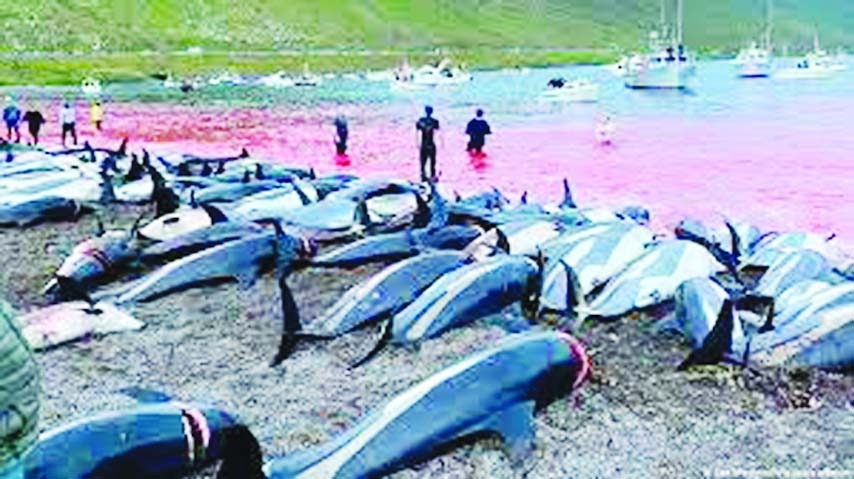
News Desk :
The custom of whale and dolphin hunting, known as grindadrap is a centuries-old practice in the Faeroe Islands and a key part of many locals’ diet. And many Faeroese point to regulations – including rules around the killing of mammals – aimed at making the practice sustainable as a reason to keep the tradition alive.
But when more than 1,400 white-sided dolphins were killed there last weekend – the largest ever recorded such catch in the area – and when local news media published graphic images and video showing the beached dolphins being dragged up in bloody waters, even some supporters of the hunts were upset, reports The New York Times.
Now the scale of the slaughter, which took place Sunday near Skalabotnur, the islands’ longest fjord, has prompted outrage from animal rights campaigners and caused divisions among those who believe dolphins should not be hunted and those who say they are still acting sustainably.
“Considering the times we are in, with a global pandemic and the world coming to a halt, it’s absolutely appalling to see an attack on nature of this scale in the Faeroe Islands,” Alex Cornelissen, CEO of the Sea Shepherd Conservation Society, an organisation that works to stop whale hunting, said in a statement.
The hunting of whales – and less commonly, dolphins – occurs throughout the year in the Faeroe
Islands, a semi-autonomous Danish archipelago of about 53,000 people between Norway and Iceland, and the practice is fully legal. Boats herd the cetaceans into a bay, where they are beached and slaughtered using an instrument that severs their spinal cords.
Animal rights groups call the hunts cruel and inhumane, and the size of Sunday’s slaughter even prompted some supporters of the long-standing cultural practice to speak out.
Government officials said that the meat, which is largely distributed for free among the community, had been shared among several districts on the islands.
But Hans Jacob Hermansen, a former chair of Faeroese Grind Association, a group that supports the practice, told local broadcaster Kringvarp Foroya that the killings undermined the work of other whale hunters and gave fuel to opponents of the hunts.
Bjarni Mikkelsen, a marine mammal biologist, said that some districts on the islands leave dolphins alone in favour of whales, which provide more meat, and that people had become less supportive of dolphin hunting.
“They are smaller, and the amount of meat for the drive is not that big, so it’s nothing to use energy and time on,” he said, adding of the large kill, “You can say generally nobody was pleased about this.”
About 265 white-sided dolphins are hunted a year, he said, and about 130,000 dolphins remain in the North East Atlantic region. An average of 600 whales are caught each year out of a population of about 100,000 around the islands, according to the Faeroese government.
Sea Shepherd criticised the hunt as having been called without proper authority and said that participants did not have a license to quickly kill the dolphins, as would typically be done. The group also said that images of the dolphins suggested that the animals had been run over by motorboats.

